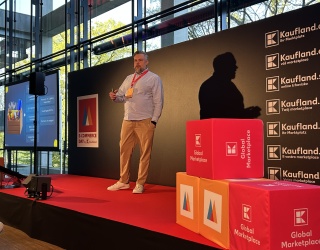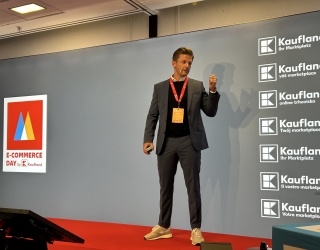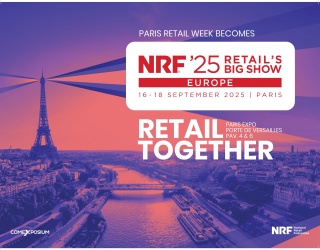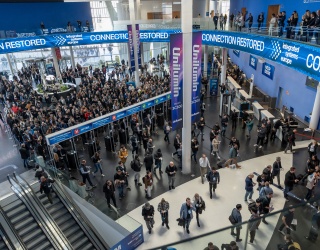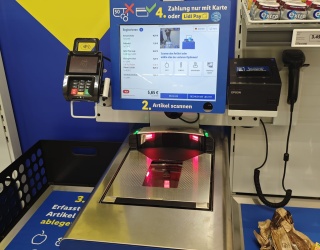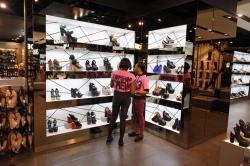
On the heels of Downton Abbey’s success on American television, British retailers are banking on a love of all things English to expand their business in the world’s biggest apparel market.
The online-only fashion retailer Asos, whose own-brand sequin sunset dress was spotted on singer Katy Perry, has lured American consumers since its 2010 debut with free delivery and returns of items ranging from $542 Edun Mesh designer jumpsuits to $11.87 own-label crop tops.
Leading the British invasion are online specialist Asos Plc, fashion chain TopShop, catalog retailer Boden, youth- focused Jack Wills Ltd., and SuperGroup Plc’s Superdry stores. Their strategies vary -- some trade on British cool, others emphasize local knowhow -- yet all focus on what they do best rather than buying an existing imprint or starting an entirely new brand that Americans have never heard of.
In doing so, the retailers are learning from the mistakes of fellow British chains such as J Sainsbury Plc and Marks & Spencer Group Plc who have retreated from North America. As boutique U.K. firms grab more of the $200 billion U.S. market, that poses a threat to American mainstays like Gap Inc., J. Crew Group Inc., and Abercrombie & Fitch, who have been busy expanding outside their home country. “U.K. retailers that are succeeding have a very strong, differentiated brand positioning that is well understood by the American consumer,” said Ian Geddes, U.K. head of retail at consultants Deloitte LLP. “They are doing well by emphasizing what their brand stands for.”
British retailers have for decades gazed longingly across the Atlantic, and the desire to broaden their operations is stronger today amid an anemic U.K. retail industry.
Winning Fans
Yet these forays often end badly. In 1988, Marks & Spencer, Britain’s largest clothing retailer, paid $750 million for Brooks Brothers, the oldest U.S. clothier, only to sell it for less than a third of the purchase price 13 years later amid a shift away from suits to more casual duds like Gap’s khakis. Tesco Plc sunk 1 billion pounds ($1.5 billion) into its Fresh & Easy U.S. grocery chain over the past five years without making a profit, and has said it will likely leave the U.S. after a review of the business.
Today, British retailers are winning fans by just being themselves. The online-only fashion retailer Asos, whose own- brand sequin sunset dress was spotted on singer Katy Perry, has lured American consumers since its 2010 debut with free delivery and returns of items ranging from $542 Edun Mesh designer jumpsuits to $11.87 own-label crop tops. It stays on top of consumer trends with an 11-strong team based in New York that makes decisions locally.
“There will be more people we put into the U.S. team so I expect them to find their footing and accelerate growth,” Finance Director Nicholas Beighton told analysts in March. “There is a bigger market in the U.S., there are more options, more channels, more digital marketing channels.”
Soaring Shares
U.S. sales increased 54 percent to 35.6 million pounds in the six months ended Feb. 28, making America Asos’s fastest- growing market. With more than one million registered customers as of December, the U.S. is now its largest market outside the U.K., with nine percent of revenue. The shares have soared 88 percent over the past year, well ahead of the FTSE All-Share Index’s 12 percent gain.
Another winner is TopShop, the flagship chain of billionaire Philip Green’s Arcadia fashion empire. TopShop, known for mid-priced trendy styles from talented young designers, entered the U.S. in 2009 with a store in Manhattan. Rather than pour millions into new outlets right away, Green opted for a low-risk approach by signing a deal last year with U.S. retailer Nordstrom Inc. to sell TopShop’s wares in some of its high-end department stores.
English Sensibility
Now that shoppers from Arizona to Pennsylvania have sampled the brand, Green has plans to expand from four to 20 TopShop and TopMan outlets in the U.S., which could generate $1 billion in sales by 2018. To help fuel the rollout, Green in December sold a 25 percent stake to private-equity firm Leonard Green & Partners in a deal that valued the chains at 2 billion pounds.
While TopShop plays a bit on its quirky English sensibility, other chains turn their British-ness up to 11, to borrow a phrase from “This is Spinal Tap,” the mock documentary about aging English rock stars. Two examples are Boden, an online and catalog retailer that focuses on womenswear and kid’s clothes, and London-based Jack Wills, which targets teens and college students.
So popular are Boden’s $120 embroidered girl’s dresses among well-to-do women in New York, Dallas and San Francisco that the company says the U.S. will overtake Britain as its biggest market in the next few years. Privately held Boden has doubled capacity at its Pennsylvania warehouse and ramped up ad spending online and in fashion magazines like In Style.
Downton Abbey
More than anything else, it’s Boden’s use of British icons like red London buses that drives the appeal and challenges the big American catalog retailers like J. Crew and LL Bean Inc.
American consumers possess an “admiration for an authentic U.K. perspective,” said Graham Hales, chief executive officer of branding consultant Interbrand, citing the popularity of Downton Abbey. “It’s a chocolate box version of the U.K. that exists in Americans’ minds.”
Boden’s U.S. revenue rose 10 percent last year to $140 million, and Granville said he expects to double that pace this year, reaching $300 million “at least” by 2017. That’s a fraction of the more than $10 billion generated in America by Gap, the biggest U.S. specialty-apparel retailer, whose sales rose 7.6 percent in the year ended Feb. 2.
Kristin Emery, a 42-year-old physiotherapist and mother of three in Virginia, started buying from Boden about five years ago. While she also shops at Gap, Nordstrom, and J. Crew, Emery spends $100 to $200 per visit at Boden, typically buying a few times each season. Her last purchase was eight pieces for her children -- ages 3, 7, and 9 -- for their spring break.
‘Anglophile Scene’
“There is an Anglophile scene there which British brands can and do tap into,” said Julian Granville, Boden’s CEO.
Jack Wills, meanwhile, has 13 outlets in the U.S., its largest overseas market. Its tagline, “Fabulously British,” mirrors that of Boden’s. The company sends brand representatives dubbed “Seasonnaires,” well-scrubbed college students, to campuses in America to host events like croquet tournaments.
While British retailers make inroads in the U.S., the best- known American retailers are looking abroad for growth. Gap will open 35 stores this year in China, a region that CEO Glenn Murphy calls “a cornerstone of future growth.” The San Francisco-based company also took its Old Navy brand outside the U.S. for the first time last year, opening an outlet in Japan, the world’s second-biggest specialty apparel market, according to data trackers Euromonitor. Gap shares have risen about 35 percent over the past year.
100 Countries
J. Crew’s direct business, which accounts for 30 percent of its $2.2 billion in sales, now ships to more than 100 countries, up from 29 a year ago. The closely held company plans to increase investments abroad, Chief Administrative Officer James Scully told analysts in a March 21 presentation.
Abercrombie & Fitch, meanwhile, has been closing underperforming U.S. stores as it grows overseas, where sales jumped 34 percent last year. A&F plans to open a store on London’s storied Savile Row, over the objections of the neighborhood’s bespoke tailors, who don’t fancy the chain’s nightclub vibe and shirtless employees.
As U.K. retailers cater to wider U.S. audiences, they risk losing the distinctiveness that defines them, said Marshal Cohen, chief retail analyst at The NPD Group in Port Washington, New York. One cautionary tale is Laura Ashley Holdings Plc, the London-based retailer known for its floral designs, which sold its unprofitable U.S. unit for $1 in 1999 after overexpanding just as its once sought-after designs fell out of fashion.
“Any old English brand will not necessarily do well,” said Isabel Cavill, senior retail analyst at Planet Retail in London. “It should be about caution, building out the brand and leveraging the Internet to see what is going on in the market.”

